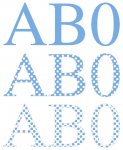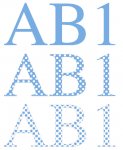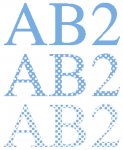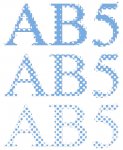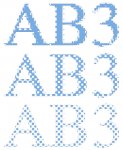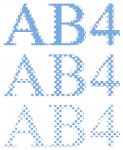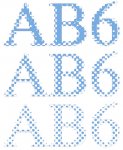@ claude72,
um, well, gee wiz, just because YOU do not know how to fix images created by scanning paper documents does not mean it can't be done !
I didn't wait for you to know how to scan text!!!

... but reading your answer gives me the feeling that YOU don't know how to do a real professionnal job... or that perhaps you read the topic to quickly: re-read carefully the quoted sentence, focusing on bolded words that gave the important informations:
"
Since they scanned crappy inkjet printouts there's shadows and hazes behind all the text and when I print using my CREO it shows up as blue haze... it goes away when I print grayscale but if a page has a picture or something, I'm stuck with it.
The 2 bold words mean that the crappy scans are made in color mode (RGB or CMYK), that is a
CONTONE mode... (and that's make the difference!!!)
... and now re-read carefully my answer (still focusing on bolded word):
"
You don't need a technic help, but a wizard-stick or a miracle: a contone scann will never be able to output correct text, even with a top quality scann..."
You can do what you want: raise the résolution, or raise the screen ruling, use magic softwares or implore God or sell your soul to Satan,
a CONTONE mode picture will never be able to print a correct crisp text, and will always print hazy text: that's a basic law of DTP and a basic knowledge in printing (and a common mistake made by many users), the haze comes from the rasterization by the printer RIP of the contone pixels in a screen... contone pixels always need a screen to be printed (basis of printing), and the screen always gives haze (basis of Postcript, rasterization, DTP)...
• raising the scan résolution is absolutely no use because with a contone picture what is printed are not the pixels of the picture but the dots of the screen, and the haze comes from the way that the screen is handled in contone picture,
• raising the screen ruling (when possible) can lower the haze and hide more or less the flaw... but it's only a workaround that will made the printing not too bad, but will never really fix the flaws. With a 175 lpi screen, the haze of the text begins to be almost invisible, and a 200 lpi screen will hide it enough to made it invisible... but does your paper accept a 200 lpi screen??? another workaround is to use stochastic screen will helps greatly in lowering the flaws...
(ink-jet printers use stochastic screens: that's why this flaw is often so lowered by ink-jet printing that non-professionnal users and bad designers don't see it on their ink-jet printings...
... and being not aware of DTP basis, offset-printing technologies and limitations, they often make the mistake to scann texts in contone mode, believing that their text-pictures will output as good from an offset press than from their ink-jet printers)
So, if you go on with contone pictures, whatever you can do will only improve a bad picture and lower the flaws due to the bad quality of the picture: suppress or lower the shadows of a bad scann, lower the haze in the picture due to the scanner-descreening of a paper printed scanned text, but the printed result of a contone picture text will still be crap: strongly smelling or "unsmelling" crap depending of the picture, but crap...
If you want to print correct crisp text with scanned text, you just have to use the 1-bit (or line-art or line-works) mode for your pictures.
The 1-bit mode pictures can be printed directly by ink-jet and laser printers and offset presses and don't need any screening to be printed, eliminating the haze due to the screening.
But the 1-bit mode needs a different resolution than contone pictures: the good resolution for 1-bit pictures is commonly 1200 ppi... (you can lower to 800 ppi without any noticable degradation, and exceptionnally to 600 ppi)...
That's not a problem when you scan your own pictures, you simply have to set your scanner to the good résolution...
... but when you receive crappy contone pictures bad scanned at the standard 300 ppi commonly used for contone pictrures, as it is not possible to have a good printing of 1-bit picture with a resolution as low as 300 ppi, so you cannot fix the problem by simply transforming a 300 ppi contone text scan in a 300 ppi 1-bit scan!!!...
Sometimes, it is possible to "save" the job when the "designer" used too big 300 dpi pictures, scaled at a lower size, that can (with chance) give a real output resolution of 600 ppi or more: it is then possible to transform the RGB or CMYK or Grayscale text-pictures in 1-bit text-pictures and output a good printing...
But in
exify job:
• the operator that made this crap has already shown her incompetence by scanning text in contone mode, so she has probably made all the other standard mistakes matching with her incompetence, and has probably scanned the image at the "standard" 300 ppi resolution and at real size... so, it is not possible to have a correct output résolution for 1-bit picture...
• even if she had a sudden unexpected lightning of intelligence, and made the scans at 600 ppi (that is a sufficient resolution to save the job) the file is a PDF, and PDF has the hability to resample the pictures, and contone pictures are resample at 300 ppi in the default setting: so whatever was the resolution of the scans, 300 or 600 or else, making the PDF has probably resample the contone scanned text at 300 ppi, as it resamples all contone pictures...
... so, there is no way to save this job, it's crap, it will stay crap.
******
To understand better what I am explaining, just have a look at the linked pictures below:
- there is no scanning in this pictures, then no degradation due to the scanner,
- picture texts have been done by direct convertion from vector to pixels in Photoshop,
- and shown pictures come directly as a file from an Agfa Viper RIP, I simply made a colorization and added an outline to show the real shape:
each picture is the real output of an imagesetter from a text in 8 pt size, printed at 2400 dpi with a 150 lpi screen and magnified 33,33 times:
• "AB0" is a vector text: no comment, it's the perfect shape of vectors...
• "AB1" and "AB2" are pixel 1-bit texts at 2400 and 1200 ppi:
- perfect shape, even with only 1200 dpi,
- and look at the edge of the screened shape: screen dots are cut to match exactly with the shape of the characters.
• "AB3", "AB4", "AB5", and "AB6" are pixel grayscale texts at 2400, 1200, 300 and ppi: crappy shape, due to:
- extra dots outside the characters,
- and most of the dots that are on the edge of the characters have a part ouside the shape
- and you can notice that the resolution doesn't change anything: the very high résolution 2400 ppi picture is as crappy than the 225 ppi picture (225 ppi is the normal résolution for 150 lpi screen)...
The difference between vectors and pixels is here:
- the RIP rasterization of vectors can "cut" the screen dots to match exactly with the exact shape of the object,
-
the RIP rasterization of pixels pictures leaves screen dots outside the shape and CANNOT "cut" the screen dots on the edge, leaving part of them outside the shape...
... and these extra outside and partially outside the shape screen dots are both altering the shape of the object (character or else) and create the haze.
So, do what you want, but text in contone picture will always look hazy!!!
exify said:
it goes away when I print grayscale but if a page has a picture or something, I'm stuck with it.
As a pixel picture is not able to mix pixels in contone and 1-bit modes, the only solution, when having a high enough resolution, is to separate each picture in 2 pictures, "simply" by duplicating the picture file, and erasing the unwanted elements in each file to create:
• one picture at 300 ppi, in contone mode (color or gray) for the pictures and colored/gray objects,
• one picture at minimum 600 ppi (better 800, much better 1200) in 1-bit mode for the black text and for line-art drawings,
and rebuilt each page by superimposing this 2 pictures (the contone below, and the 1-bit above) in 2 pictures boxes of XPress or InDesign...
***********
The vector and 1-bit pictures:




